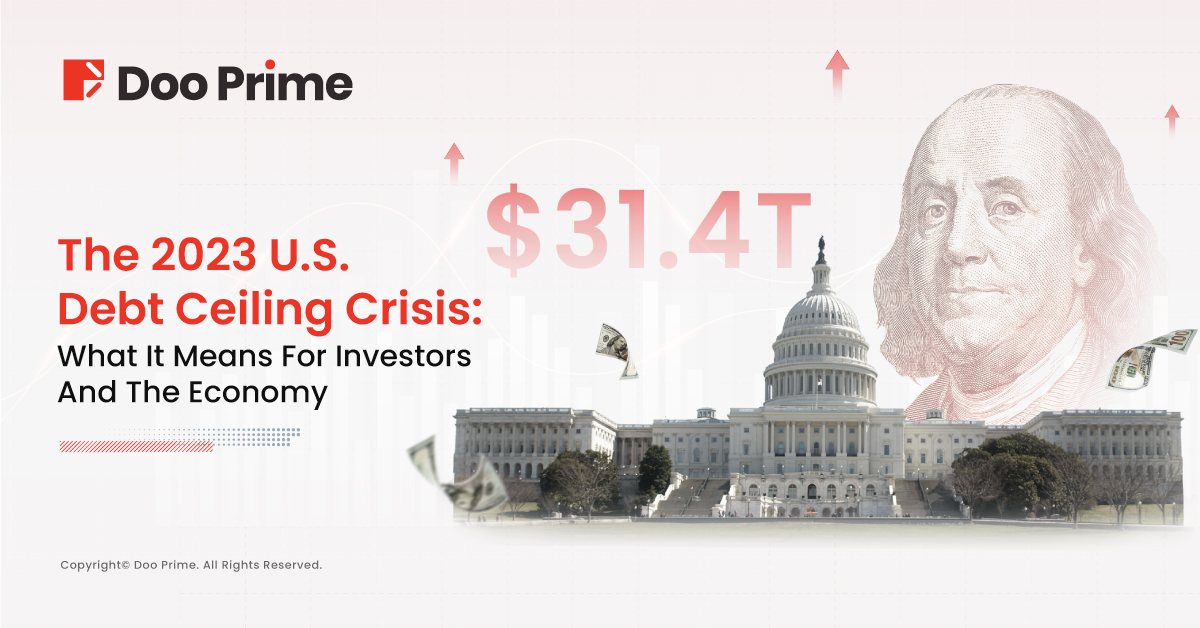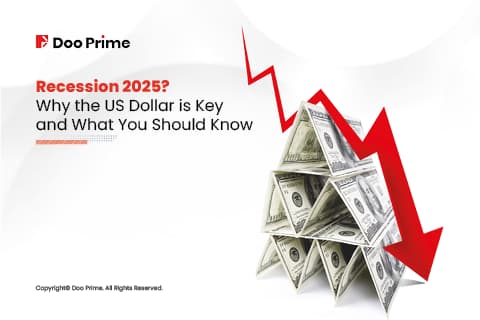
The ongoing issue of the U.S. economy has captured global attention once again, after U.S. Treasury Secretary Janet Yellen issued a warning that the U.S. government could default as early as 1st June 2023 if the debt ceiling is not resolved.
If Congress fails to act in a timely manner, the U.S. government will be unable to fulfill its financial obligations, leading to potential economic collapse and jeopardizing global financial stability. Currently, Congress is at an impasse due to partisan disputes.
As we approach 2023, the U.S. debt ceiling crisis looms over the economy, causing concern for investors and financial experts alike. Understanding the urgency of this issue is crucial, as it can have a significant impact on the economy and financial markets worldwide.
In this article, we will explore how the 2023 U.S. debt ceiling issue may affect the economy and examine its potential threats to global financial stability. We will also look back at previous debt ceiling negotiations to better understand the market’s reaction and how it may impact asset prices.
Understanding The Urgency Of The 2023 U.S. Debt Ceiling Crisis
Let’s backtrack to the point when the U.S. hit its debt ceiling.

On 19th January 2023, the U.S. federal government reached its legal USD 31.4 trillion borrowing limit, known as the “debt ceiling.” The amount of increase since 2000 is staggering, totaling USD 25 trillion.
As a result, the Treasury Department began implementing “extraordinary measures” to keep the government paying its bills, such as curbing certain government investments.
After months of bitter disagreements, Democrats and Republicans have made little progress towards a resolution on the issue. Republicans are proposing spending cuts to raise the borrowing limit, while Democrats and the White House are pushing for a stand-alone increase in the debt limit.
To add, U.S. Treasury Secretary Janet Yellen issued a warning that if Congress does not raise the debt limit, the U.S. government may not be able to meet its financial obligations as early as 1st June. This has put pressure on Capitol Hill to act quickly to prevent a catastrophic default.
As a response, President Joe Biden has invited the top Republicans and Democrats on Capitol Hill to a meeting next week to discuss the urgent issue.

Without an increase or suspension of the debt ceiling, the government may default as early as 1st June, prompting Congress and the White House to swiftly reach a resolution.
Currently, the negotiations surrounding the debt ceiling have reached an impasse, and both political parties are making a last-ditch effort to come to an agreement.
According to an analysis by senior fellows at the Brookings Institution – Wendy Edelberg and Louise Sheiner – an extended deadlock in Congress over the debt ceiling could cause “significant damage” to the U.S. economy. This comes at a time when the country is already grappling with high inflation and banking turmoil, making the situation even more precarious.
Edelberg and Sheiner warned that if the debt ceiling is not raised and the U.S. Treasury is unable to meet its obligations, the economic consequences could quickly accumulate and potentially trigger a severe recession.
How Could The 2023 U.S. Debt Ceiling Issue Impact The Economy

The U.S. debt ceiling crisis has led to an increase in credit default swaps (CDS), with the 6-month and 1-year CDS hitting a record high. The 3-month U.S. bond rates have also risen to their highest value since February 2001, raising concerns about the impact on the Fed’s monetary policy.
The debt ceiling issue has the potential to create dramatic volatility in financial markets, with a possible sell-off of U.S. bonds, leading to a spike in interest rates and a fall in U.S. stocks and other risk assets.
This could lead to a recession, with a negative impact on consumption and investment, and undermining business confidence, resulting in massive layoffs and a rise in unemployment.
Furthermore, if interest rates on national debt soar, it could also increase the government’s debt service burden, leading to a surge of federal borrowing costs of up to USD 750 billion over the next 10 years, according to Brookings Institution.
As a result, if the debt ceiling crisis intensifies, the Fed may be forced to turn to a more dovish monetary policy. It may refrain from raising rates in June and instead, opt for rate cuts in the second half of the year to mitigate the crisis.
After the Fed’s FOMC meeting on 3rd May, the market’s expectation of no rate hikes in June rose to 89.3%, which increased to 91.5% on 5th May. The market also anticipates a rate cut in September in the range of 4.75% to 5.00%, with a probability of 51.4%.
Will The U.S. Debt Ceiling Crisis Pose A Threat To Global Financial Stability?

Economists have cautioned that the potential consequences of a U.S. debt default extend far beyond the borders of the United States. Such an event would cause immense damage to the global economy, which is already struggling with sluggish growth.
The Wall Street Journal has also reported that doubts about the U.S. government’s ability to pay back investors who buy its securities could have serious financial and economic consequences worldwide.
In addition, U.S. Treasury Secretary Janet Yellen herself warned in January that a debt default could have broad global implications. Critics such as Stanley Druckenmiller have long criticized the U.S. government for irresponsible spending, calling for urgent action to curb the ballooning federal debt.
At the same time, MacGuineas, president of the Committee for a Responsible Federal Budget, has pointed out that policymakers have not put forth any plan to address the looming insolvency of Medicare and Social Security, which are only a few years away.
How Did The Market React During Previous Debt Ceiling Negotiations?
The most recent episode of debt ceiling drama occurred in 2011 when Congress raised the ceiling only two days before the Treasury was expected to exhaust its resources.
Shortly after, Standard & Poor’s downgraded the U.S. credit rating from AAA to AA+. The reaction of risk assets was negative, with stocks dropping, the dollar selling off, and credit spreads widening.
However, a robust rally in Treasuries – driven by other market concerns at the time, such as the European sovereign debt crisis – offset the overall market impact.
Apart from 2011, the market has responded more to the prevailing economic and market conditions of the time during recent episodes, and any volatility related to the debt ceiling has been short-lived.
The Impact Of The 2023 U.S. Debt Ceiling Crisis On Asset Prices

U.S. Bonds: Short-end rates surge
As the U.S. approaches the debt ceiling, asset prices are expected to react, particularly U.S. bonds. In previous debt ceiling crises, short-term government notes experienced a rapid drop in value and a significant rise in yield, while 10-year U.S. bonds remained a safe investment option.
Despite spikes in sovereign credit default risk and rating downgrades in past crises, there was no actual default. However, the current 3-month U.S. bond rate has hit its highest level since February 2001, and experts predict that short-end U.S. bonds will continue to be under selling pressure until a resolution to the debt ceiling issue is reached.
U.S. stocks: Brace for potential decline
Based on historical experience, U.S. stocks may experience a sharp drop in the month leading up to the “X date” as investors sell off risky assets amid concerns over the debt ceiling crisis. This often results in a rapid rise in the VIX index. However, once the bill to raise or suspend the debt ceiling is passed, the stock market typically stabilizes.
Although U.S. stocks have been trading within a narrow range since the end of March, it is expected that there may still be a potential for a rapid adjustment as the debt ceiling issue intensifies. If this occurs, investors may want to take advantage of the dip and consider holding onto stocks for the long term once the crisis is resolved.
U.S. Dollar: Bearish outlook continues
The U.S. dollar’s short-term trend is heavily influenced by the government’s handling of the debt ceiling issue. Looking back at the historical experiences of the debt ceiling crises in 2011, 2013, and 2021, the dollar tends to enter a downward cycle from the time the Treasury Department begins issuing warnings about the debt ceiling issue and taking “extraordinary measures” until the bill to revise the debt ceiling is ultimately passed.
Since the fourth quarter of last year, the dollar index has been on a downward path, and we remain bearish on the dollar at this time. The U.S. sovereign credit crisis triggered by the debt ceiling is one of the contributing factors, alongside the three logical factors: the dollar has not yet fully factored in the expected Fed policy shift, the safe-haven role that the dollar played during the epidemic has vanished with the pandemic’s end, and de-dollarization has significantly weakened offshore dollar demand.
A Way Forward With The 2023 U.S. Debt Ceiling Crisis

Ultimately, the 2023 U.S. debt ceiling crisis is a significant concern that could have far-reaching consequences for the U.S. economy and beyond. The market has been reactive to past debt ceiling negotiations, with short-term government notes falling rapidly and yields on 3-month U.S. bonds rising sharply.
This time, short-term U.S. bonds are expected to remain under selling pressure until the debt ceiling issue is finally resolved. Additionally, the U.S. dollar’s short-term trend is heavily influenced by the government’s handling of the debt ceiling issue, and continue to be bearish on the dollar at this time.
The impact of the debt ceiling crisis on asset prices remains a critical concern for investors. As we await the outcome of negotiations, it is essential to keep a close eye on the situation and consider potential consequences for investment portfolios.
| About Doo Prime
Our Trading Products
Securities | Futures | Forex | Precious Metals | Commodities | Stock Indices
Doo Prime is an international pre-eminent online broker under Doo Group, which strives to provide professional investors with global CFD trading products in Securities, Futures, Forex, Precious Metals, Commodities, and Stock Indices. At present, Doo Prime is delivering the finest trading experience to more than 90,000 clients, with an average trading volume of more than USD 51.223 billion each month.
Doo Prime entities respectively holds the relevant financial regulatory licenses in Seychelles, Mauritius, and Vanuatu with operation centers in Dallas, Sydney, Singapore, Hong Kong, Dubai, Kuala Lumpur, and other regions.
With robust financial technology infrastructure, well-established partnerships, and an experienced technical team, Doo Prime boasts a safe and secure trading environment, competitive trading costs, as well as deposit and withdrawal methods that support 20+ different currencies. Doo Prime also incorporates 24/7 multilingual customer service and extremely fast trade execution via multiple industry-leading trading terminals such as MT4, MT5, TradingView, and Doo Prime InTrade, covering over 10,000 trading products.
Doo Prime’s vision and mission are to become a financial technology-focused broker, streamlining international global financial products investment.
For more information about Doo Prime, please contact us at:
Phone:
Europe: +44 11 3733 5199
Asia: +852 3704 4241
Asia – Singapore: +65 6011 1415
Asia – China: +86 400 8427 539
E-mail:
Technical Support: [email protected]
Account Manager: [email protected]
Forward-looking Statements
This article contains “forward-looking statements” and may be identified by the use of forward-looking terminology such as “anticipate”, “believe”, “continue”, “could”, “estimate”, “expect”, “hope”, “intend”, “may”, “might”, “plan”, “potential”, “predict”, “should”, or “will”, or other variations thereon or comparable terminology. However, the absence of such terminology does not mean that a statement is not forward-looking. In particular, statements about the expectations, beliefs, plans, objectives, assumptions, future events, or future performance of Doo Prime will be generally assumed as forward-looking statements.
Doo Prime has provided these forward-looking statements based on all current information available to Doo Prime and Doo Prime’s current expectations, assumptions, estimates, and projections. While Doo Prime believes these expectations, assumptions, estimations, and projections are reasonable, these forward-looking statements are only predictions and involve known and unknown risks and uncertainties, many of which are beyond Doo Prime’s control. Such risks and uncertainties may cause results, performance, or achievements materially different from those expressed or implied by the forward-looking statements.
Doo Prime does not provide any representation or warranty on the reliability, accuracy, or completeness of such statements. Doo Prime is not obliged to provide or release any updates or revisions to any forward-looking statements.
Risk Disclosure
Trading in financial instruments involves high risks due to the fluctuation in the value and prices of the underlying financial instruments. Due to the adverse and unpredictable market movements, large losses exceeding the investor’s initial investment could incur within a short period of time. The past performance of a financial instrument is not an indication of its future performance. Investments in certain services should be made on margin or leverage, where relatively small movements in trading prices may have a disproportionately large impact on the client’s investment and client should therefore be prepared to suffer significant losses when using such trading facilities.
Please make sure you read and fully understand the trading risks of the respective financial instrument before engaging in any transaction with Doo Prime’s trading platforms. You should seek independent professional advice if you do not understand any of the risks disclosed by us herein or any risk associated with the trade and investment of financial instruments. Please refer to Doo Prime’s Client Agreement and Risk Disclosure and Acknowledgement Notice to find out more.
Disclaimer
This information is addressed to the general public solely for information purposes and should not be taken as investment advice, recommendation, offer, or solicitation to buy or sell any financial instrument. The information displayed herein has been prepared without any reference or consideration to any particular recipient’s investment objectives or financial situation. Any references to the past performance of a financial instrument, index, or a packaged investment product shall not be taken as a reliable indicator of its future performance. Doo Prime and its holding company, affiliates, subsidiaries, associated companies, partners and their respective employees, make no representation or warranties to the information displayed and shall not be liable for any direct, indirect, special or consequential loss or damages incurred a result of any inaccuracies or incompleteness of the information provided, and any direct or indirect trading risks, profit, or loss arising from any individual’s or client’s investment.



